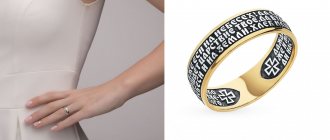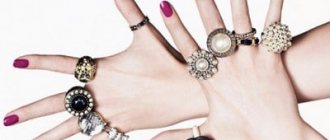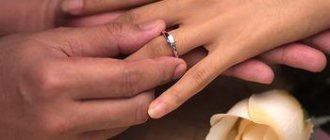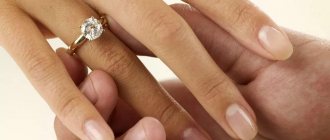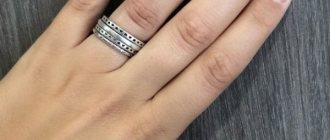The loss of a loved one is always a tragedy that each of us experiences in our own way. Someone is trying to quickly “format the disk” of their own memory in order to drown out severe mental suffering, while others, on the contrary, want to preserve bright memories of a deceased person.
We are all different: both positions have the right to life, including in terms of external manifestations. Some continue to wear the ring of their deceased spouse, while others strive to quickly get rid of the jewelry with a sad story. What is the right thing to do? Let's consider the options.
Is it possible to wear the ring of a deceased person?
Many people believe that wearing the ring of a deceased person is generally undesirable. It is believed that the jewelry is saturated with the energy of the wearer and absorbs it especially intensely at moments of greatest emotional stress. What could be more exciting than death?
Esotericists consider rings to be the most powerful energy storage devices among all jewelry. It’s difficult to say objectively whether this is true, but among the heroes of terrifying stories about cursed jewelry, rings are the leaders.
Gold wedding ring in the SUNLIGHT catalog
Particularly dangerous are jewelry inherited from people who died a terrible death - violent or as a result of a serious, long-term illness accompanied by suffering. Supporters of occult practices do not recommend wearing such jewelry without prior energetic cleansing.
Nevertheless, much depends on how the person lived and how he treated the future heir to the ring. For example, in most cases, it is absolutely safe for a daughter to wear rings from her deceased mother. Moreover: they can become powerful amulets that ward off misfortune, like the hands of a loving mother.
That is why family jewelry that is passed down from generation to generation is highly valued. They try not to let them out of the family: inside it they serve as guardians of the family’s energy, and outside it they can cause a lot of trouble.
Every ancient noble family has family jewelry, whose history is stained with blood. Particularly indicative in this regard are decorations from royal treasuries. Of course, over the centuries they have seen a lot: intrigues, executions, poisonings, and sometimes within the same family. Family rings are favorable to representatives of this kind, but to others, to put it mildly, not so much.
Rings of deceased strangers, much less ill-wishers, should definitely not be worn. It’s good if your energy is more powerful, then over time the jewelry will adapt to your wavelength. But during the adaptation period, you may feel some inexplicable discomfort.
The literature describes many cases where rings with history literally subjugated their owners, pushing them to commit terrible atrocities, driving them crazy and slowly killing them. Most of them are fiction, but who knows, maybe there is a grain of truth in it.
All this must be taken into account when considering the question of whether a widow can wear a wedding ring (in addition to the decoration of the deceased spouse). If harmony and love reigned in the family, and the husband died a natural death without much suffering, esotericists say: it is possible to wear the wedding ring of the deceased spouse.
It should also be taken into account that a husband’s wedding ring can become a talisman for a widow and protect her from misfortunes along the path of life. Moreover, it will not become an obstacle to a new marriage: it is unlikely that the soul of the deceased, no matter where it is, will wish loneliness for his loved one.
It is believed that the spouse's engagement ring serves as a kind of mental link between the soul of the deceased and his widow. The deceased may come to his wife in a dream, give her instructions or warn her against decisions that will not be for her good.
And if you put mysticism aside, then the ring is simply a memory of the departed person and the wonderful moments that the spouses lived together. If the jewelry evokes bright memories and warm feelings, you can and should wear it.
Gold wedding ring in the SUNLIGHT catalog
If the ring causes sadness and pain from loss, it must be removed immediately. This is no longer a tribute to memory, but self-torture, which no one needs. Listen to your own feelings and don’t chase external expressions of grief!
Just wait
She met her future husband, as often happens now, on the Internet. According to our heroine, she registered on a dating site for fun, but met fate. A man wrote to her, they began to communicate, the correspondence dragged on for a long six months, during which there was not a single meeting. After some time, the couple finally met, and the future husband announced that he was leaving for the army.
“He then said: “Just wait.” We will definitely be together." I left a silver pendant in the shape of a wolf as a souvenir. Let's just say that my last name is directly related to this predator. And so it happened. At first we didn’t communicate for four months—the phone was taken away. Then came the night calls and text messages. I won’t say that it’s easy to wait; it was hard for me, like everyone else, because over time I fell in love,” she recalls with a smile.
How to wear a wedding ring for a widow?
There are many traditions associated with wedding rings. For the most part, they are determined by the mentality of specific peoples and the religious affiliation of their representatives.
Looking ahead, let's say that not a single scripture indicates what widowed spouses should do with wedding rings. All traditions associated with these sorrowful moments are nothing more than inventions of people, for some reason they have taken root and are sometimes elevated to the rank of dogma.
Let's look at the traditions of various nations as they apply to wedding rings and widowhood.
Orthodox traditions
When getting married, Orthodox newlyweds put wedding rings on each other's ring fingers of their right hands. Catholics in some countries, including Belarus, Germany, and Austria, do the same.
Wedding rings are put on in a similar way, because it is believed that behind the right shoulder of every baptized person there is a guardian angel protecting him, and at the same time, the consecrated marriage.
A widow's wedding ring in Russia is worn on the ring finger of the left hand, as a sign of grief and memory of the deceased. However, this is not spelled out in any church canons: it is simply a tradition invented by people and rooted in society.
Sometimes widows wear their rings on the ring finger of their right hand, and their deceased husbands' wedding rings on their left hand. Someone takes off their wedding ring and, together with their spouse’s engagement ring, donates it to the church or keeps it next to the icons, in the red corner.
All sorts of forms of charity are also very welcome: you can, for example, sell a piece of jewelry (one or both) and donate the money to a shelter for the elderly, an orphanage, a needy family, and so on.
Most Catholics and Protestants
Let's start with the fact that not all Christian denominations accept the wedding ceremony and the traditional exchange of rings. In particular, representatives of some branches of Protestantism, as well as the majority of near-Christian sectarians, do not exchange rings.
Nevertheless, Catholics and Protestants still practice exchanging rings, and wear them mainly on the left hand, on the ring finger. It is believed that this hand is closer to the heart, therefore, responsible for love and family happiness.
Gold wedding ring with diamonds (go to the SUNLIGHT catalogue)
Widowers and widowers sometimes continue to wear their rings on their left hand and place the wedding bands of the deceased on their right hand. More often, spouses’ rings are not worn at all, but their own are moved to the right hand, which sometimes leads to multicultural confusion.
In principle, as in the previous case, there are no strict religious guidelines on this matter: the choice remains with the individual.
Jews
Many Jews have adopted the traditions of the states where they live, and the custom of wearing wedding rings at all stages of family life is no exception.
If we turn to the Torah and the traditions of Orthodox Jews, a fundamentally different custom emerges that is not inherent in representatives of other faiths. During a Jewish wedding, the groom puts a ring on the bride's right finger (usually the index finger, less often the middle finger).
Jewish men do not wear wedding rings at weddings. A ring (necessarily simple, without design or stones) is a symbolic gift to the bride, confirmation of the groom’s well-being and a reminder of her new status.
After the wedding, a woman can wear a ring on any hand. And in the event of the death of their spouses, Jewish women usually take off their wedding bands, keep them at home or donate them to charity - according to their own judgment.
Muslims
Islam is a young but very dogmatic religion. Suffice it to remember that it strictly prohibits depicting people and animals - supposedly this is the prerogative exclusively of Allah - smoking and drinking alcohol even in minimal quantities.
The situation with wedding rings is correspondingly sad: Muslims do not have such a tradition. Men are generally prohibited from wearing gold jewelry. The permissible maximum is 4.375 grams of silver, and even then not in all movements of Islam. And the dependence of a man on a woman, embodied in rings, completely contradicts the spirit of a true Muslim.
A man can give his bride a ring for her wedding, but without any symbolic meaning. It will be just a gift that a woman is free to use as she pleases. That is, after the death of her husband, she can wear the ring in memory of her husband, sell it or give it as a gift - this is a personal matter for the widow.
The wearing of gold and silk by Muslim women is permitted solely as an indulgence to their natural weaknesses. And ladies who profess Islam can decorate themselves with them only for their own husbands.
Recommendations from psychologists
The main advice of psychologists is that the decision made by the widow or widower be comfortable for them.
If it is painful for a woman or a man to come across constant reminders of the lost and ended happiness together, then it is better not to leave such a significant thing on your hand, so as not to reopen the wound.
If, on the contrary, the presence of a ring creates a feeling of security and that a loved one is looking after your other half from the other world, then the jewelry should be left.
Advice! For religious widows, it is recommended to ask for advice from a confessor, since the support of significant people at such a difficult moment is incredibly important.
What to do with your dead husband's wedding ring?
So, a woman who has lost her husband faces a difficult choice that only she herself can make. Let's consider the options:
- Wear only your ring. In this case, it is better to move your ring to the hand opposite to the one on which married people wear it.
- Wear your deceased husband's wedding ring with your own. You can wear your ring on your right hand and your husband’s engagement ring on your left. It is allowed to wear both rings on one hand (usually the left) and even on the same finger. In this case, the husband's ring is secured with his own ring on top, so as not to lose it.
- Move the rings onto the chain. Some people wear the rings of their deceased spouses (sometimes along with their own) on chains around their necks, near their chests. A worthy alternative to this option could be gaitan (leather, silk, etc.). It is not recommended to hang a ring on the same chain with a cross.
- Keep rings at home. You can place the memorial ring(s) in your jewelry box or in a separate place if you don't want to reminisce too often. Some Christians keep the wedding rings of the dead near the icons.
- Part with jewelry. There are a lot of options here: donate to the church (crosses, church utensils, frames for icons are cast from gold rings), melt it down for other jewelry, sell it, keeping the money for yourself to live on, or donate it to charity.
If desired, you can choose an alternative place to wear the deceased spouse's ring. You can wear the engagement ring on a pin, like a brooch, just in your purse, purse or pocket. The main thing is not to lose the memento.
View of Orthodox priests
The Orthodox Church believes that keeping a wedding ring is a completely acceptable solution. There are no prohibitions, so everything depends only on the person and his views.
The only objection that the church points out is the transfer of the product to children. The clergy are against such actions because it can cause serious harm to the child. In addition to the psychological impact, the child may develop ailments and various diseases, since the energy of the deceased person is simply unacceptable for him.
If there is no one close to you to give this item to, and the widow herself is afraid to keep it at home, then the priests offer to take the rings to the church for the purpose of charity. All rings will be recycled and used to improve the temple.
A story about why it is better not to put things in the grave
“We come into this world with nothing. And they must leave in the same way” - this is the opinion of the church when it comes to whether it is necessary to put the things of the deceased in the grave. There is a popular belief that objects of living people left with a deceased person can drag the former owner along with them.
This story was told to us by a resident of Ulan-Ude, who wanted to remain anonymous. This happened about ten years ago, but she still remembers those events that left a lot of gray hair on her head.
How to clear a ring of negativity?
If you intend to wear the ring of a deceased relative or spouse with a dubious history (not the best lifestyle, violent death, tense relationship), then it is better to cleanse it of hostile energy. In any case, that’s what esotericists say.
Gold wedding ring (go to the SUNLIGHT catalogue)
Some sources recommend taking the ring to church and asking for a prayer service to be read over it. This is not an entirely correct message: the Christian religion fights with all its might against all manifestations of superstition and the occult and does not welcome belief in all kinds of energy drinks and corruption. Nevertheless, a request to consecrate a piece of jewelry will not be denied: a similar ritual can be performed on virtually any item.
You can clean the ring at home. To do this, just hold it over a candle flame, in running water or salt. In particularly advanced cases, it is recommended to use several options simultaneously: three days in water, salt and on a windowsill, in sunlight and moonlight.
If you clean the ring in salt, under no circumstances eat it afterwards. It is better not to keep this salt in the house beyond what is necessary. The easiest way is to flush it down the toilet and throw away the container in which you cleaned it.

